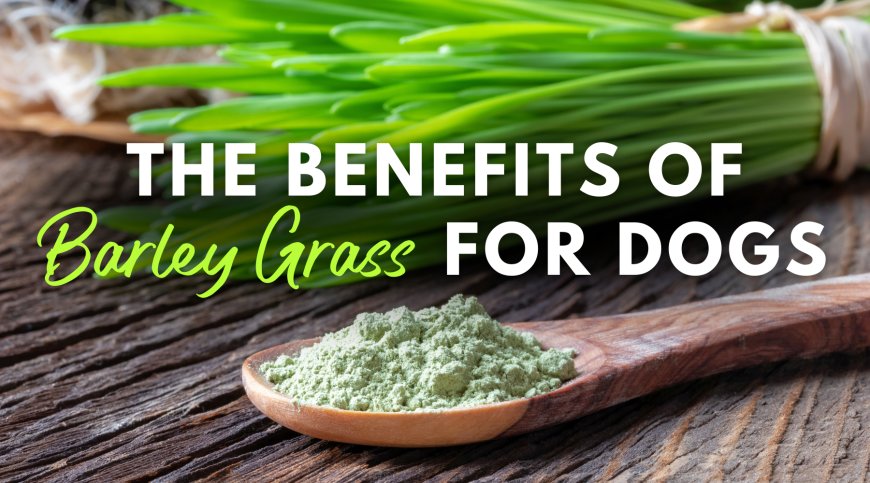The Wholesome Benefits of Barley Grass for Canine Wellness
Thanks to its nutritional profile, immune-boosting and digestive support properties, barley grass can be extremely beneficial for your dog’s health and well-being. From joint mobility to detoxification, this articles dives in the science of enhancing your dog's vitality and health at every stage of life.More

In recent years, barley grass has been growing in popularity as a superfood for humans; however, dogs have consumed grass instinctively for thousands of years.
The primary reason is that barley grass has been shown to have a wide range of health-promoting properties, including immune support, digestive health, detox, and reduction in joint pain and inflammation.
Barley grass is abundant in chlorophyll, a molecule that is very close to hemoglobin in the blood, but also contains superoxide dismutase, lutonarin, saponarin, vitamins, minerals, and eight essential amino acids [1] [2], which provide a wide range of health benefits in dogs and people. The complete essential amino acid profile also makes barley grass one of the most known nutrient-rich foods.
Barley Grass: History and Ancient Tradition
Barley grass has been cultivated for thousands of years, with ancient civilizations like the Sumerians, Egyptians, Greeks, and Romans recognizing its nutritional and medicinal properties. It was used for food, medicine, rituals, and valued for its high nutrient content. Ancient healers like Hippocrates and Pliny the Elder used barley grass to treat illnesses and digestive disorders.
A Closer Look at the Nutritional Benefits of Barley Grass for dogs
-
Vitamins
Barley grass is rich in vitamins such as vitamin A, vitamin C, and vitamin K. These vitamins play essential roles in maintaining a dog's overall health. For example, vitamin A is important for vision, immune function, and skin health, while vitamin C acts as an antioxidant and supports immune function.
-
Minerals
Barley grass contains important minerals such as calcium, magnesium, and iron. These minerals are essential for, but not limited to, bone health, muscle function, and blood oxygen transport.
In fact, barley grass contains 11 times the calcium and 30 times the vitamin B1 found in cow's milk, seven times the vitamin C in oranges, six times the carotene content in spinach, and four times the vitamin B1 content of wheat flour.
-
Antioxidant Allies: Barley Grass and Canine Health
Barley grass contains antioxidants such as flavonoids and chlorophyll. Antioxidants help neutralize harmful free radicals in the body which can reduce oxidative stress and inflammation. Saponarin in barley grass possesses strong antioxidant activities, which can prevent diseases caused by oxidative damage, such as various cancers, inflammations, and cardiovascular diseases. [3]
-
Barley Grass and Canine Digestive Health
Barley grass is an excellent source of dietary fiber, which plays a crucial role in digestive health. It promotes regular bowel movements, prevents constipation, and supports the growth of beneficial gut bacteria and microbiome health. It also plays an important role in blood sugar regulation and reducing the risk of obesity in dogs.
Barley grass can be also helpful in calming down gastrointestinal inflammation in colitis, pancreatitis, and improving the function of the intestinal lining [4] [5] [6].
The Role of Barley Grass in Your Dog's Mobility
The wide variety of bioactive compounds in barley grass includes saponarin, a crucial functional component with natural anti-inflammatory properties [7].
A study has also confirmed that extracts from barley grass have demonstrated notable efficacy in the treatment of osteoarthritis and rheumatoid arthritis.
Our fermented joint and mobility product JointButter contains this beneficial plant.
To learn more, click the link below.
FAQ for Barley Grass for Dogs:
-
How much barley grass is safe for dogs?
Similarly to other super greens, feeding 1- 3 teaspoons per day based on the size of your dog should be fine. Large amounts of barley grass may potentially cause digestive problems such as vomiting, nausea, and diarrhea. In such cases, reduce the amount and re-evaluate the dose.
-
Is barley grass suitable for dogs of all ages?
Yes, barley grass is beneficial for all life stages, including puppies, middle aged and senior dogs and it is especially beneficial in dogs that tend to overheat easily and seek cooler temperatures.
-
Can barley grass support detoxification?
Barley grass has excellent detox properties and helps to support the liver and eliminates toxins, and heavy metals.
-
Can barley grass offer relief for dogs experiencing allergies?
Allergies and the immune system are closely intertwined with the gut, immune system health and toxin buildup. This is why barley grass can benefit dogs suffering from allergies.
References
-
Lahouar, L., El-Bok, S., & Achour, L. (2015). Therapeutic potential of young green barley leaves in prevention and treatment of chronic diseases: an overview. The American Journal of Chinese Medicine, 43(7), 1311–1329. https://doi.org/10.1142/S0192415X15500743
-
Acar, O., Turkan, I., & Ozdemir, F. (2001). Superoxide dismutase and peroxidase activities in drought sensitive and resistant barley (Hordeum vulgare L.) varieties. Acta Physiologiae Plantarum, 23(3), 351–356. https://doi.org/10.1007/s11738-001-0043-8
-
Kamiyama, M., & Shibamoto, T. (2012). Flavonoids with Potent Antioxidant Activity Found in Young Green Barley Leaves. Journal of Agricultural and Food Chemistry, 60(25), 6260–6267. https://doi.org/10.1021/jf301700j
-
Ikeguchi, M., Tsubata, M., Takano, A., et al. (2014). Effects of young barley leaf powder on gastrointestinal functions in rats and its efficacy-related physicochemical properties. Evidence-based Complementary and Alternative Medicine, 2014, 7. https://doi.org/10.1155/2014/974840.974840
-
Ohtake, H., Yuasa, H., Komura, C., Miyauchi, T., Hagiwara, Y., & Kubota, K. (Year). Studies on the constituents of green juice from young barley leaves: antiulcer activity of fractions from barley juice.
-
Ferrone, M., Raimondo, M., & Scolapio, J. S. (2007). Pancreatic enzyme pharmacotherapy. Pharmacotherapy, 27(6), 910–920. https://doi.org/10.1592/phco.27.6.910
-
Seo, K. H., Park, M. J., Ra, J. E., et al. (2014). Saponarin from barley sprouts inhibits NF-κB and MAPK on LPS-induced RAW 264.7 cells. Food and Function, 5(11), 3005–3013.











































